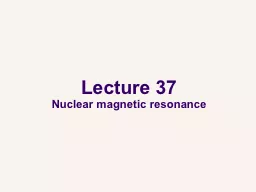

Nuclear magnetic resonance The use of NMR in chemical research was pioneered by Herbert S Gutowski of Department of Chemistry University of Illinois who established the relationship between chemical shifts and molecular structures He also discovered spinspin coupling ID: 929579
Download Presentation The PPT/PDF document "Lecture 37 Nuclear magnetic resonance" is the property of its rightful owner. Permission is granted to download and print the materials on this web site for personal, non-commercial use only, and to display it on your personal computer provided you do not modify the materials and that you retain all copyright notices contained in the materials. By downloading content from our website, you accept the terms of this agreement.
Slide1
Lecture 37
Nuclear magnetic resonance
Slide2Nuclear magnetic resonance
The use of NMR in chemical research was pioneered by
Herbert S. Gutowski of Department of Chemistry, University of Illinois, who established the relationship between chemical shifts and molecular structures. He also discovered spin-spin coupling.Foundation of magnetic spectroscopy.Proton NMR.
Slide3Circular electric current = magnet
Electrons in
p
,
d, f
orbitals
Electron spinNuclear spin
angular
momentum
charge
magnetic
moment
mass
Slide4Magnet-magnetic-field interaction
high energy
low energy
Classical
Magnetic moment
Magnetic field
Quantum
Slide5Tesla
Nikola Tesla
Public domain image from Wikipedia
kgm
2
/s
C
J
kg
T (Tesla)
1 T = 1 V s / m
2
Field strength in 500 MHz NMR ($0.5M) = 11.7 T
Field strength in 1 GHz NMR ($20M) = 23.5 T
Strongest continuous magnetic field = 45 T
(National High Magnetic Field Lab at Tallahassee, FL)
Slide6Electrons in
p
, d, f orbitals
First-order perturbation theory
Bohr
magneton
9.724×10
−24
J/T
(2
l
+ 1)-fold
degeneracy
(field off)
Zeeman effect (field on)
Slide7Quantum electrodynamics
g
-value
2.002319…
2-fold
degeneracy
(field off)
Electron spin
α
β
ESR or EPR (field on)
Slide8Nuclear
g
-factor
p
roton: 5.586
2-fold
degeneracy
(field off)
Nuclear spin
α
β
NMR (field on)
Nuclear
magneton
1800 times smaller
than Bohr
magneton
P
roton
mass
Negative sign
positive nuclear charge
Slide9Proton NMR
α
β
Sample
Sweep coils
Radio
freq
Slide10Proton NMR spectra
Overall intensity
Groups of peaks
Relative intensities of groups of peaks
Pattern in each group (hyperfine structure)
Slide11Overall intensity
α
β
Intensity of a NMR signal
~ energy of RF radiation absorbed / time
~ Δ
E ×
number of excess
α
spins
~
B
2
/
T
Stronger magnet + lower temperature
excess
α
spins
Slide12Group of peaks: chemical shifts
Resonance freq.
Chemical shift
Resonance freq. of TMS
Si(CH
3
)
4
“ppm”
α
β
Slide13Group of peaks: chemical shifts
Resonance freq.
Chemical shift
Shielding
constant
Slide14Group of peaks: chemical shifts
Shielding
constant
+
Slide15Group of peaks: chemical shifts
Shielding
constant
Slide16Group of peaks: chemical shifts
14 12 10 8 6 4 2 0
δ
-COO
H
-C
H
O
Ar
-
H
ArO
H
RO
H
-C
H
-
-C
H
2
-
RC
H
3
Slide17Relative intensities
C
2H6
O
H
H
2
H
3
OH
CH2
CH3
CH
3
CH
2
OH
RO
H
-C
H
2
-
RC
H
3
4 2 0
δ
Slide18Hyperfine structure
CH
3
CH
2
OH
OH
CH
2
CH3
α
β
α
α
β
β
H
nearby H
Spin-spin coupling:
Slide19Hyperfine structure
CH
3
CH
2
OH
OH
CH
2
CH
3
α
β
α
α
β
β
H
H
Spin-spin coupling:
ββ
α
α
βα, α
β
H
2
α
β
,
β
α
β
β
α
α
Slide20Hyperfine structure
CH
3CH2
OH
OH
CH
2
CH
3
1
1
1
1
2
1
1
3
3
1
1
4
6
4
1
Pascal’s triangle
nearby H
nearby H
2
nearby H
3
nearby H
4
Slide21CH
3
CH2OH
OH
CH
2
CH
3
Q
: Why doesn’t the proton in the OH group cause splitting?
A
: The proton undergoes a rapid exchange with protons in other ethanol or water molecules; its spin is indeterminate in the time scale of spectroscopic transitions; this causes lifetime broadening of spectral line rather than splitting.
?
Hyperfine structure
Slide22CH
3
CH2OH
OH
CH
2
CH
3
Q
: Why is there no spin-spin coupling between the two protons in the CH
2
group?
A
: There
is
spin-spin coupling between them; however, its effect on the peaks is null and undetectable; this is because these protons are chemically and magnetically equivalent.
?
?
Hyperfine structure
Slide23Hyperfine structure
CH
3CH2OH
Triplet
magnetic
Singlet
non-magnetic
no spin-spin coupling
with spin-spin coupling
No change in spacing
Slide24Spin-spin coupling constant
H
H
H
C
H
H
C
C
H
Slide25Spin-spin coupling constant
H
H
Fermi
contact
Fermi
contact
Covalent bond
singlet-coupling
higher energy??
Fermi contact
lower energy!
higher energy??
Slide26Spin-spin coupling constant
H
C
Fermi
contact
Fermi
contact
Covalent
bond
singlet
coupling
H
Covalent
bond
singlet
coupling
Hund
Slide27Spin-spin coupling constant
H
C
C
H
H
C
H
Martin
Karplus
Department of Chemistry
University of Illinois
ILLIAC
Karplus
equation
Image (c) University of Illinois
Slide28Magnetic resonance imaging: MRI
Paul
Lauterbur
(far right)
Department of Chemistry
University of Illinois
Magnetic field gradient
Intensity
~ number of protons (in water) at
x
x
Resonance frequency
~ location (
x
)
Public domain image from Wikipedia
Slide29Summary
We have studied the foundation of magnetic interactions and magnetic spectroscopy.
We have learned the theory of proton NMR as an essential tool for chemical structural analysis.The origins of chemical shifts, hyperfine structures, and spin-spin coupling constants are discussed as well as their relation to molecular structures.